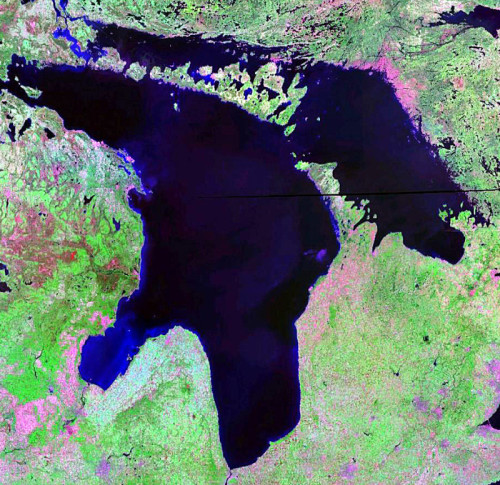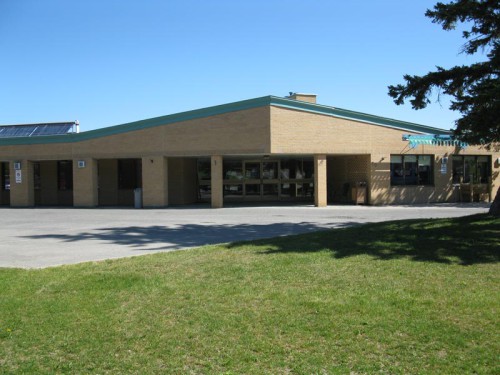LAKE HURON—The International Joint Commission (IJC) announced on Friday its much hoped-for recommendation that the governments of Canada and the United States investigate structural options to restore water levels in Lake Michigan-Huron by 13 to 25 centimetres, including a comprehensive cost-benefit analysis and a detailed environmental impact study. In layman’s terms, the IJC is recommending structures on the St. Clair River that will slow down the outflow of water from Lake Huron.
Specifically, the commission encouraged governments to focus on options that would not exacerbate future high water levels but that would provide relief during periods of low water.
“Although future water levels are uncertain, we cannot ignore the damage from record low water levels,” said Joe Comuzzi of Thunder Bay, Canadian chair of the commission, in an IJC press release. “From Georgian Bay to Door County, from shoreline property owners to the shipping industry, we heard calls for action, and we urge governments to act in response to our recommendations.”
The commission also endorsed the International Upper Great Lakes Study Board’s modelling and monitoring recommendations, recognizing that critical information and tools are needed to adaptively manage this dynamic system, IJC’s statement continues.
In order to better understand how future water supplies may affect water levels, the commission calls upon governments to better coordinate the binational collection of climate-related data and to strengthen climate change modelling capacity to help improve water management. This approach underpins the adaptive management framework recommended by the study so that decision-makers at all levels of government have the tools and processes to make informed decisions. The commission will issue specific recommendations regarding adaptive management for the Great Lakes system following its deliberation of the Great Lakes/St. Lawrence River Adaptive Management Task Team final report. Comments on this report ended last month, with the Manitoulin Area Stewardship Council adding its voice to the report, calling adaptive management a “do nothing plan.”
“Meeting the ongoing challenges of extreme low and high levels on the Great Lakes should be guided by robust adaptive management to inform decisions, at all levels, with the best information and full community engagement,” said Dereth Glance, one of the IJC’s US commissioners. “Our goal is for stakeholders throughout the Great Lakes to become engaged in the process and use the latest scientific information to prepare for extreme water levels and storms.”
As reported previously in The Expositor, restoration structures investigated by the IJC included sills and underwater hydroelectric turbines located in the St. Clair River that would come at a cost of between $30 and $70 million. It would also take upwards of 20 years for such a commitment to take place, the IJC had warned.
“We commend and thank the Study Board and the more than 200 experts who worked on this project,” said Canadian Commissioner Lyall Knott. “Their report advances scientific knowledge and provides governments with a solid basis for action.”
However in a dissenting opionion, Lana Pollack, US chair of the commission, chose not to sign the commission report because, in her view, it places insufficient emphasis on climate change and the need for governments to pursue and fund adaptive management strategies in the Great Lakes Basin. Ms. Pollack also cautioned against raising “false hopes that structures in the St. Clair River, if built, would be sufficient to resolve the suffering from low water levels of Lake Michigan-Huron, while at the same time causing possible disruption downstream in Lake St. Clair and Lake Erie.”
The International Joint Commission’s advice to governments is in response to the findings and recommendations of the International Upper Great Lakes Study. Originally focused on updating the regulation plan for Lake Superior outflows, the five-year study was expanded to include an examination of whether physical changes in the St. Clair River (such as over-dredging and de-sanding commercial businesses) were effecting the level of Lake Michigan-Huron. At an exploratory level, the study also looked at various engineering options for restoring Lake Michigan-Huron levels, including approximate construction costs and both positive and negative impacts.
MASC secretary Therese Trainor of Kagawong, observed when The Expositor told her of the IJC’s recommendation, that she believes it is also because of groups like hers and its petition, organized by volunteer Mike Wilton of Dominion Bay and presented to MP Carol Hughes by him last fall, as well as comments, together with the lobbying efforts of groups like Georgian Bay Forever and the Georgian Bay Association and responsible journalism, that have helped to turn the tide in Lake Huron’s favour. “Thank you to the public who signed the petition, came to Kagawong (to an International Upper Great Lakes Study Board public meeting) and to those who came to the Little Current hearing,” she added.
“This is obviously a move in the right direction,” Ms. Trainor said. “We are very pleased. I think public pressure finally came to bear, and we have to continue doing that.”
“Of course we want action, not years of study,” she added.
Ms. Trainor noted of Commissioner Pollack’s concerns, “it’s true, climate change is more than the IJC can handle, but at this point, any improvement is an improvement.”
“It seems to be a step in the right direction and we’re happy—we have to keep pushing,” Ms. Trainor reiterated.
The Expositor spoke with Mary Muter, chair of the Great Lakes section of Sierra Club Ontario. She explained that on Monday, the mayors of townships throughout Georgian Bay had a high power meeting with federal Conservative cabinet ministers Peter Kent, John Baird and Tony Clement in Ottawa. She explained that these mayors have tallied the cost of services due to low water levels for Georgian Bay alone for 2013 to the tune of $500 million. This included the Island municipalities of Billings, Assiginack and Central Manitoulin. The estimated cost of structures? Between $100 and $200 million and would be shared between the two countries. The math is simple, she said.
Ms. Muter said it was good news indeed that the IJC decided against its own recommendations in its multi-million dollar study. She said she disagreed with Ms. Pollack’s assessment, as managing water downstream can be done slowly and safely by placing temporary structures in the Niagara River. “This is possible to do responsibly,” she added.
“This type of integrated crisis response was studied in the 1993 IJC study but was not re-assessed under the current critical low water conditions on all of the middle Great Lakes,” said Roger Gauthier, chair of Restore Our Water International (ROWI) and a retired senior hydrologist with the US Army Corps of Engineers. “Implementation of St. Clair compensation structures could take 3-5 years at the earliest. In the meantime, other crisis response measures need to be considered by the IJC, including using its discretionary authority to immediately allow more water to flow out of Lake Superior into Lakes Michigan and Huron,” Mr. Gauthier added.
“Tony Clement indicated that the government is looking to put their heads together for a response,” Ms. Muter continued. “The Canadian government could announce funding for this to proceed, but it’s much more complicated in the US,” she added, noting money cannot be earmarked by the government for projects.
“But if the Canadian government puts the money on the table, that would almost force the US government to do the same,” she observed.
Ms. Muter said the US Army Corps of Engineers is ready to proceed at a moment’s notice, due to the fact that when Canada and the US agreed to complete deepening of the St. Clair and Detroit Rivers in 1962, “compensation measures” were supposed to have been placed in both rivers to counter increased river flows and anticipated water level lowering on the upstream lakes. Compensating measures were deployed in the Detroit River at that time, but unfortunately no corresponding compensating measures were deployed in the St. Clair River.
Prior to making these recommendations to the governments, the commission thoroughly reviewed more than 3,500 comments received from the public, including those provided at 13 public hearings held throughout the upper Great Lakes basin last summer, including a hearing in Little Current.
The IJC has also advised the governments of Canada and the United States that it will implement this year an improved plan for regulating Lake Superior outflows at Sault Ste. Marie. The new plan, Lake Superior Regulation Plan 2012, provides additional benefits compared to the current regulation, especially during extreme water supply conditions.





